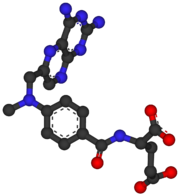- Methotrexate
-
"Amethopterin" redirects here. Not to be confused with aminopterin.
Methotrexate 

Systematic (IUPAC) name (2S)-2-[(4-{[(2,4-diaminopteridin-6-yl)methyl](methyl)amino}benzoyl)amino]pentanedioic acid Clinical data Trade names Trexall AHFS/Drugs.com monograph MedlinePlus a682019 Pregnancy cat. D(AU) X(US) Legal status Prescription Only (S4) (AU) POM (UK) ℞-only (US) Routes oral, IV, IM, SC, intrathecal Pharmacokinetic data Bioavailability 17–90% Metabolism hepatic Half-life 3–15 hours (dose dependent) Excretion renal 48–100% Identifiers CAS number 59-05-2 
ATC code L01BA01 L04AX03 PubChem CID 126941 DrugBank DB00563 ChemSpider 112728 
UNII YL5FZ2Y5U1 
KEGG D00142 
ChEBI CHEBI:44185 
ChEMBL CHEMBL34259 
Chemical data Formula C20H22N8O5 Mol. mass 454.44 g/mol SMILES eMolecules & PubChem  (what is this?) (verify)
(what is this?) (verify)Methotrexate (rINN) (
 /mɛθɵˈtrɛkseɪt/), abbreviated MTX and formerly known as amethopterin, is an antimetabolite and antifolate drug. It is used in treatment of cancer, autoimmune diseases, ectopic pregnancy, and for the induction of medical abortions.[1] It acts by inhibiting the metabolism of folic acid. Methotrexate began to replace the more toxic antifolate aminopterin starting in the 1950s. The drug was developed by Yellapragada Subbarao.
/mɛθɵˈtrɛkseɪt/), abbreviated MTX and formerly known as amethopterin, is an antimetabolite and antifolate drug. It is used in treatment of cancer, autoimmune diseases, ectopic pregnancy, and for the induction of medical abortions.[1] It acts by inhibiting the metabolism of folic acid. Methotrexate began to replace the more toxic antifolate aminopterin starting in the 1950s. The drug was developed by Yellapragada Subbarao.Contents
Medical uses
Chemotherapy
Methotrexate was originally developed and continues to be used for chemotherapy either alone or in combination with other agents. It is effective for the treatment of a number of cancers including: breast, head and neck, leukemia, lymphoma, lung, osteosarcoma, bladder, and trophoblastic neoplasms.[1]
Autoimmune disorders
It is used as a treatment for some autoimmune diseases including: rheumatoid arthritis, psoriasis, psoriatic arthritis, and Crohn's disease, to name a few. Although methotrexate was originally designed as a chemotherapy drug (in high doses), in low-doses methotrexate is a safe and well tolerated drug in the treatment of certain autoimmune diseases. Because of its efficacy and safety, low-dose methotrexate is now first-line therapy for the treatment of rheumatoid arthritis.[2][3] Indeed, multiple studies and reviews showed that patients receiving methotrexate for up to 1 year had less pain, functioned better, had fewer swollen and tender joints, and had less disease activity overall as reported by themselves and their doctors. X-rays also showed that the progress of the disease slowed or stopped in many patients receiving methotrexate.[4]
It has also been used for multiple sclerosis but is not approved by the Food and Drug Administration.[1]
Pregnancy termination
Methotrexate is commonly used (generally in combination with misoprostol) to terminate pregnancies during the early stages (i.e., as an abortifacient). It is also used to treat ectopic pregnancies.[1][5]
Administration
It can be taken orally or administered by injection (intramuscular, intravenous, subcutaneous, or intrathecal).[1] Oral doses are taken weekly not daily.[1] Routine monitoring of the complete blood count, liver function tests, and creatine are recommended.[1] Measurements of creatinine are recommended at least every 2 months.[1]
Adverse effects
The most common adverse effects include: ulcerative stomatitis, low white blood cell count and thus predisposition to infection, nausea, abdominal pain, fatigue, fever, dizziness and rarely pulmonary fibrosis.[1]
Methotrexate is a highly teratogenic drug and categorized in pregnancy category X by the FDA. Women must not take the drug during pregnancy, if there is a risk of becoming pregnant, or if they are breastfeeding. Men who are trying to get their partner pregnant must also not take the drug. To engage in any of these activities (after discontinuing the drug), women must wait until the end of a full ovulation cycle and men must wait three months.[citation needed]
Central nervous system reactions to methotrexate have been reported, especially when given via the intrathecal route which include myelopathies and leucoencephalopathies. It has a variety of cutaneous side effects, particularly when administered in high doses.[6]
Generally, the more "nonspecific" action a pharmacological substance has, the more possible side effects can be expected. Methotrexate has, like all "cell toxic" substances, a broad array of possible adverse effects. Care should always be taken to read the manufacturer's original instructions for the preparation in question.[citation needed]
Drug interactions
Penicillins may decrease the elimination of methotrexate and thus increase the risk of toxicity.[1] While they may be used together increased monitoring is recommended.[1]
Mechanism of action
 The similar structure of dihydrofolic acid (top) and methotrexate (bottom) suggests that methotrexate is a competitive inhibitor
The similar structure of dihydrofolic acid (top) and methotrexate (bottom) suggests that methotrexate is a competitive inhibitor
Methotrexate competitively inhibits dihydrofolate reductase (DHFR), an enzyme that participates in the tetrahydrofolate synthesis.[7] The affinity of methotrexate for DHFR is about one thousand-fold that of folate. DHFR catalyses the conversion of dihydrofolate to the active tetrahydrofolate. Folic acid is needed for the de novo synthesis of the nucleoside thymidine, required for DNA synthesis. Also, folate is needed for purine base synthesis, so all purine synthesis will be inhibited. Methotrexate, therefore, inhibits the synthesis of DNA, RNA, thymidylates, and proteins.
Methotrexate acts specifically during DNA and RNA synthesis, and thus it is cytotoxic during the S-phase of the cell cycle. Logically, it therefore has a greater toxic effect on rapidly dividing cells (such as malignant and myeloid cells, and gastrointestinal and oral mucosa), which replicate their DNA more frequently, and thus inhibits the growth and proliferation of these noncancerous cells, as well as causing the side effects listed below. Facing a scarcity of dTMP, rapidly dividing cancerous cells undergo cell death via thymineless death.
For the treatment of rheumatoid arthritis, patients should supplement their diets with folate. In these cases, inhibition of DHFR is not thought to be the main mechanism, but rather the inhibition of enzymes involved in purine metabolism, leading to accumulation of adenosine, or the inhibition of T cell activation and suppression of intercellular adhesion molecule expression by T cells.[8]
Pharmacokinetics
Methotrexate is a weak dicarboxylic acid with pKa 4.8 and 5.5, and thus it is mostly ionized at physiologic pH. Oral absorption is saturatable and thus dose-dependent, with doses less than 40 mg/m2 having 42% bioavailability and doses greater than 40 mg/m2 only 18%. Mean oral bioavailability is 33% (13-76% range), and there is no clear benefit to subdividing an oral dose. Mean intramuscular bioavailability is 76%.
Methotrexate is metabolized by intestinal bacteria to the inactive metabolite 4-amino-4-deoxy-N-methylpteroic acid (DAMPA), which accounts for less than 5% loss of the oral dose.
Factors that decrease absorption include food, oral nonabsorbable antibiotics (e.g. vancomycin, neomycin, and bacitracin), and more rapid transit through the gastrointestinal tract (GI) tract, such as diarrhea, while slower transit time in the GI tract from constipation will increase absorption. Methotrexate is also administered in the placenta accreta, inhibiting the blood circulation to the target site.[citation needed]
History
See also: History of cancer chemotherapyIn 1947, a team of researchers led by Sidney Farber showed aminopterin, a chemical analogue of folic acid developed by Yellapragada Subbarao Lederle, could induce remission in children with acute lymphoblastic leukemia. The development of folic acid analogues had been prompted by the discovery that the administration of folic acid worsened leukemia, and that a diet deficient in folic acid could, conversely, produce improvement; the mechanism of action behind these effects was still unknown at the time.[9] Other analogues of folic acid were in development, and by 1950, methotrexate (then known as amethopterin) was being proposed as a treatment for leukemia.[10] Animal studies published in 1956 showed the therapeutic index of methotrexate was better than that of aminopterin, and clinical use of aminopterin was thus abandoned in favor of methotrexate. In that same year, methotrexate was found to be a curative treatment for choriocarcinoma—a solid tumor, unlike leukemia, which is a cancer of the marrow.[9] The drug was then investigated as a treatment for many other cancers, alone or in combination with other drugs, and was studied for other, noncancer indications in the 1970s. In 1988, it was approved by the U.S. Food and Drug Administration (FDA) to treat rheumatoid arthritis.[11] In 2002, the FDA approved methotrexate to treat Crohn's disease.[12]
References
- ^ a b c d e f g h i j k "Methotrexate". The American Society of Health-System Pharmacists. http://www.drugs.com/monograph/methotrexate.html. Retrieved 3 April 2011.
- ^ Low-Dose Methotrexate: A Mainstay in the Treatment of Rheumatoid Arthritis. Cronstein, B. Pharmacological Reviews June 2005 vol. 57 no. 2 163-172. doi: 10.1124/pr.57.2.3
- ^ American College of Rheumatology Subcommittee on Rheumatoid Arthritis Guidelines (2002) Guidelines for the management of rheumatoid arthritis: 2002 update. Arthritis Rheum 46: 328-346.
- ^ Based on Suarez-Almazor M, Osiri M, Emery P, Ottawa Methods Group. Rheumatoid arthritis. In Evidence-based Rheumatology. London: BMJ Books, 2003.
- ^ Mol, F.; Mol, B.W.; Ankum, W.M.; Van Der Veen, F.; Hajenius, P.J. (2008). "Current evidence on surgery, systemic methotrexate and expectant management in the treatment of tubal ectopic pregnancy: a systematic review and meta-analysis". Human Reproduction Update 14 (4): 309–19. doi:10.1093/humupd/dmn012. PMID 18522946.
- ^ Scheinfeld, N (2006). "Three cases of toxic skin eruptions associated with methotrexate and a compilation of methotrexate-induced skin eruptions". Dermatology online journal 12 (7): 15. PMID 17459301.
- ^ Rajagopalan, P. T. Ravi; Zhang, Zhiquan; McCourt, Lynn; Dwyer, Mary; Benkovic, Stephen J.; Hammes, Gordon G. (2002). "Interaction of dihydrofolate reductase with methotrexate: Ensemble and single-molecule kinetics". Proceedings of the National Academy of Sciences 99 (21): 13481–6. doi:10.1073/pnas.172501499. PMC 129699. PMID 12359872. http://www.pubmedcentral.nih.gov/articlerender.fcgi?tool=pmcentrez&artid=129699.
- ^ Johnston, Andrew; Gudjonsson, Johann Eli; Sigmundsdottir, Hekla; Runar Ludviksson, Björn; Valdimarsson, Helgi (2005). "The anti-inflammatory action of methotrexate is not mediated by lymphocyte apoptosis, but by the suppression of activation and adhesion molecules". Clinical Immunology 114 (2): 154–63. doi:10.1016/j.clim.2004.09.001. PMID 15639649.
- ^ a b Bertino JR (2000). "Methotrexate: historical aspects". In Cronstein BN, Bertino JR. Methotrexate. Basel: Birkhäuser. ISBN 978-3-7643-5959-1. http://books.google.com/?id=VCAFHzHAotsC. Retrieved November 21, 2009.[page needed]
- ^ Meyer, Leo M.; Miller, Franklin R.; Rowen, Manuel J.; Bock, George; Rutzky, Julius (1950). "Treatment of Acute Leukemia with Amethopterin (4-amino, 10-methyl pteroyl glutamic acid)". Acta Haematologica 4 (3): 157–67. doi:10.1159/000203749. PMID 14777272.
- ^ http://arthritis.about.com/od/mtx/p/methotrexate.htm
- ^ "FDA Approves Remicade (Infliximab)/Methotrexate Combination to Improve Physical Function in Rheumatoid Arthritis". Doctor's Guide. http://www.docguide.com/news/content.nsf/news/8525697700573E1885256B6E00574353. Retrieved 11 September 2010.
External links
- National Rheumatoid Arthritis Society (NRAS) article on Methotrexate
- Chembank entry on methotrexate
- Methotrexate general article from NIH
- Methotrexate Injection MedlinePlus article from NIH
- Patient Education - Methotrexate from American College of Rheumatology
- U.S. National Library of Medicine: Drug Information Portal - Methotrexate
Immunomodulators: Immunosuppressive drugs / Immunosuppressants (L04) Intracellular
(initiation)purine synthesis inhibitors: Azathioprine • Mycophenolic acid
pyrimidine synthesis inhibitors: Leflunomide • Teriflunomide
antifolate: MethotrexateTNF-α inhibitorIntracellular
(reception)Extracellular Serum target
(noncellular)Complement component 5 (Eculizumab) • TNFs (Infliximab, Adalimumab, Certolizumab pegol, Afelimomab, Golimumab) • Interleukin 5 (Mepolizumab) • Immunoglobulin E (Omalizumab) • BAYX (Nerelimomab)
IL-12 and IL-23 (Lebrikizumab, Ustekinumab)Cellular targetCD3 (Muromonab-CD3, Otelixizumab, Teplizumab, Visilizumab) • CD4 (Clenoliximab, Keliximab, Zanolimumab) • CD11a (Efalizumab) • CD18 (Erlizumab) • CD20 (Afutuzumab, Rituximab, Ocrelizumab, Pascolizumab) • CD23 (Gomiliximab, Lumiliximab) • CD40 (Teneliximab, Toralizumab) • CD62L/L-selectin (Aselizumab) • CD80 (Galiximab) • CD147/Basigin (Gavilimomab) • CD154 (Ruplizumab)
BLyS (Belimumab) • CTLA-4 (Ipilimumab, Tremelimumab) • CAT (Bertilimumab, Lerdelimumab, Metelimumab) • Integrin (Natalizumab) • Interleukin-6 receptor (Tocilizumab) • LFA-1 (Odulimomab)
IL-2 receptor/CD25 (Basiliximab, Daclizumab, Inolimomab)
T-lymphocyte (Zolimomab aritox)Unsorted-cept (Fusion)CTLA-4 (Abatacept, Belatacept) • TNF inhibitor (Etanercept, Pegsunercept) • Aflibercept • Alefacept • RilonaceptSpecific antirheumatic products / DMARDs (M01C) Quinolines Gold preparations Other Penicillamine #/Bucillamine • Chloroquine #/Hydroxychloroquine • Leflunomide • Sulfasalazine # • antifolate (Methotrexate #) • thiopurine (Azathioprine) #M: JNT
anat(h/c, u, t, l)/phys
noco(arth/defr/back/soft)/cong, sysi/epon, injr
proc, drug(M01C, M4)
Categories:- Dihydrofolate reductase inhibitors
- Immunosuppressants
- Antineoplastic antimetabolites
- Antirheumatic products
- Antifolates
- Benzamides
Wikimedia Foundation. 2010.


